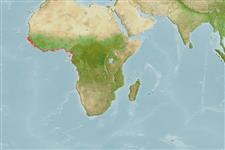Actinopterygii (ray-finned fishes) >
Beloniformes (Needle fishes) >
Belonidae (Needlefishes)
Etymology: Strongylura: Greek, strongylos = round + Greek, oura = tail (Ref. 45335).
Environment / Climate / Range
Ecology
Marine; brackish; pelagic-neritic; depth range 0 - ? m. Tropical, preferred ?; 14°N - 17°S
Eastern Atlantic: Senegal and Guinea to the Gulf of Guinea and Angola. Reported from the Gambia River (Ref. 28587).
Size / Weight / Age
Maturity: Lm ? range ? - ? cm
Max length : 150 cm SL male/unsexed; (Ref. 2683); common length : 60.0 cm SL male/unsexed; (Ref. 2683)
Dorsal
spines
(total): 0;
Dorsal
soft rays
(total): 13-16;
Anal
spines: 0;
Anal
soft rays: 14 - 18. Diagnosis: body elongate; upper and lower jaws extremely long, forming a stout beak armed with strong teeth; nostrils in depression before eyes (nasal pit); gill rakers absent; pelvic fins abdominal; 13-16 dorsal-fin rays; no lateral keel on caudal peduncle; caudal fin emarginated (Ref. 57228).
Occurs in coastal areas and brackish lagoons. Feeds mainly on small fishes (Ref. 28587). Oviparous (Ref. 205). Eggs may be found attached to objects in the water by tendrils on the egg's surface (Ref. 205).
Life cycle and mating behavior
Maturity | Reproduction | Spawning | Eggs | Fecundity | Larvae
Collette, B.B. and N.V. Parin, 1990. Belonidae. p. 592-597. In J.C. Quero, J.C. Hureau, C. Karrer, A. Post and L. Saldanha (eds.) Check-list of the fishes of the eastern tropical Atlantic (CLOFETA). JNICT, Lisbon; SEI, Paris; and UNESCO, Paris. Vol. 2. (Ref. 5757)
IUCN Red List Status (Ref. 115185)
CITES (Ref. 94142)
Not Evaluated
Threat to humans
Harmless
Human uses
Fisheries: minor commercial
More information
ReferencesAquacultureAquaculture profileStrainsGeneticsAllele frequenciesHeritabilityDiseasesProcessingMass conversion
Tools
Special reports
Download XML
Internet sources
Estimates of some properties based on models
Phylogenetic diversity index (Ref.
82805): PD
50 = 0.5001 [Uniqueness, from 0.5 = low to 2.0 = high].
Bayesian length-weight: a=0.00074 (0.00039 - 0.00141), b=3.13 (2.97 - 3.29), in cm Total Length, based on LWR estimates for this species & Genus-body shape (Ref.
93245).
Trophic Level (Ref.
69278): 4.5 ±0.80 se; Based on food items.
Resilience (Ref.
69278): Very Low, minimum population doubling time more than 14 years (Preliminary K or Fecundity.).
Vulnerability (Ref.
59153): Very high vulnerability (76 of 100) .
